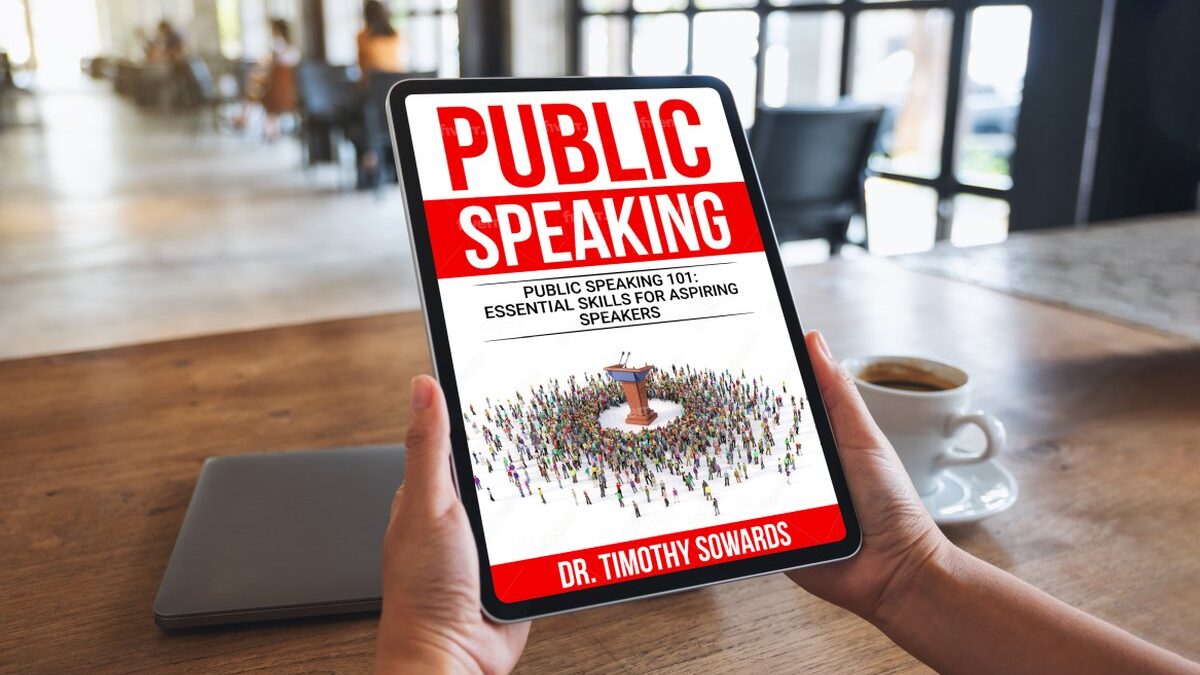Public Speaking 101 by Dr. Timothy Sowards
Public Speaking Series Book 2
The journey of becoming an exceptional public speaker requires continual growth and practice. Embrace a mindset of continuous improvement, dedicate time to practice your skills, and seek out opportunities for growth. Remember that public speaking is a valuable skill that transcends industries and professions. By investing in your growth and practice, you can become a confident and influential speaker in your chosen niche.
For public speakers, the ability to captivate an audience and deliver a powerful message is paramount. However, even the most experienced speakers understand that there is always room for improvement. Embracing a mindset of continuous growth allows you to push the boundaries of your comfort zone and explore new techniques to enhance your speaking abilities.
Practice is the cornerstone of improvement in public speaking. Just like any other skill, the more you practice, the better you become. By dedicating time to rehearse your speeches, you can refine your delivery, work on your body language, and fine-tune your message. Remember that practice not only builds skills but also boosts your confidence, allowing you to speak with conviction and authenticity.
Public speaking skills are not only relevant to public speakers themselves but also to professionals in various niches. Whether you are a sales and marketing professional, a teacher, a government official, or a nonprofit organization representative, the ability to communicate effectively is crucial to your success. By embracing continued growth and practice, you can refine your communication skills and become a more persuasive and influential speaker in your specific field.
Excerpt from Public Speaking 101 © Copyright 2024 Dr. Timothy Sowards
Chapter 4: Delivery Techniques for Engaging Presentations
Body Language and Nonverbal Communication
In the world of public speaking, mastering the art of effective communication goes beyond the mere words we say. It is the body language and nonverbal cues that truly have the power to captivate an audience and leave a lasting impact. Understanding and harnessing the power of body language is essential for aspiring speakers, regardless of their niche or profession.
Body language, often referred to as nonverbal communication, encompasses the gestures, facial expressions, posture, and overall physical presence that accompanies our words. It is a powerful tool that can either enhance or undermine our message, making it crucial to master this aspect of public speaking.
For public speakers, body language serves as a nonverbal conversation with the audience. It allows you to establish a connection, build trust, and convey your message more effectively. By being aware of your body language, you can ensure that your words align with your nonverbal cues, creating a seamless and impactful delivery.
When it comes to presentation skills for students, understanding body language can greatly enhance their ability to engage with their classmates and teachers. By using confident posture, maintaining eye contact, and employing appropriate gestures, students can effectively convey their ideas and contribute to discussions with ease and confidence.
In the realm of sales and marketing professionals, body language plays a significant role in establishing rapport and building trust with potential clients. By adopting open and welcoming gestures, mirroring the body language of the client, and maintaining an attentive posture, sales professionals can create a positive and persuasive environment that encourages clients to trust and invest in their products or services.
Teachers and educators, on the other hand, rely on body language to create a conducive learning environment. By using appropriate facial expressions, gestures, and body posture, educators can effectively engage their students and convey information in a way that is easily understood and retained.
Politicians and government officials understand the importance of body language in public speaking. They utilize strong and confident body language to convey authority, inspire trust, and connect with their constituents. By employing gestures that emphasize key points, maintaining a strong and upright posture, and using facial expressions that reinforce their message, politicians can leave a lasting impression on their audience.
Lastly, nonprofit organizations can benefit greatly from understanding the power of body language. By using warm and welcoming gestures, maintaining positive eye contact, and employing open and inclusive body language, nonprofit speakers can effectively convey their message and create an emotional connection with their audience, encouraging them to support their cause.
In conclusion, body language and nonverbal communication are essential skills for public speakers across various niches. By mastering these skills, speakers can create a powerful and impactful message that resonates with their audience, regardless of their profession or field of expertise.
Vocal Variety and Articulation
Vocal Variety and Articulation: Mastering the Power of Your Voice
Effective public speaking goes beyond just delivering a well-prepared speech. It requires the skillful use of your voice to engage, persuade, and inspire your audience. In this subchapter, we will explore the importance of vocal variety and articulation and how it can elevate your speaking abilities to new heights. Whether you are a student, a sales professional, a teacher, a politician, or a member of a nonprofit organization, mastering these techniques will significantly enhance your public speaking skills.
Vocal variety is the ability to vary your pitch, pace, volume, and tone to add interest and emphasis to your words. It is a powerful tool that can captivate your audience and keep them engaged throughout your presentation. By modulating your voice, you can convey emotions, emphasize key points, and create a dynamic and memorable experience for your listeners. We will delve into various techniques, such as using pauses, vocal inflections, and vocal projection, to help you develop and refine your vocal range.
Articulation, on the other hand, pertains to how clearly and distinctly you pronounce your words. A well-articulated speech enhances your credibility and ensures that your message is easily understood. We will discuss strategies for improving your diction, including tongue twisters, vocal warm-ups, and exercises to strengthen your speech muscles. We will also address common challenges, such as mumbling or speaking too fast, and provide practical tips to overcome them.
Furthermore, this subchapter will explore how vocal variety and articulation can be tailored to specific niches of public speaking. For students, mastering vocal variety and articulation can enhance classroom presentations, debates, and group discussions, boosting their confidence and academic performance. Sales and marketing professionals can leverage vocal techniques to deliver persuasive pitches, establish rapport with clients, and close deals successfully. Teachers and educators can engage their students by infusing their lectures with vocal variety, making complex concepts more accessible and stimulating learning. Politicians and government officials can captivate audiences with their speeches, rallying support and inspiring change. Finally, nonprofit organizations can effectively convey their mission, engage donors, and mobilize volunteers through the power of vocal variety and articulation.
In conclusion, vocal variety and articulation are essential skills for any public speaker, regardless of their niche. By harnessing the power of your voice, you can elevate your speaking abilities and leave a lasting impact on your audience. Through practical techniques and tailored advice, this subchapter will equip you with the tools to unlock your vocal potential and become a confident and influential public speaker.
My profession is online marketing and development (10+ years experience), check my latest mobile app called Upcoming or my Chrome extensions for ChatGPT. But my real passion is reading books both fiction and non-fiction. I have several favorite authors like James Redfield or Daniel Keyes. If I read a book I always want to find the best part of it, every book has its unique value.







